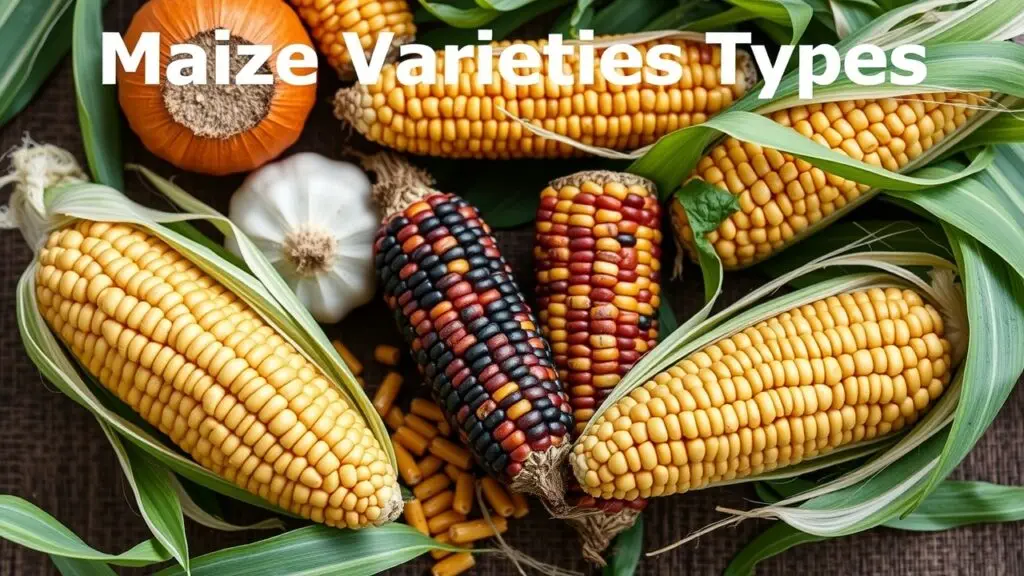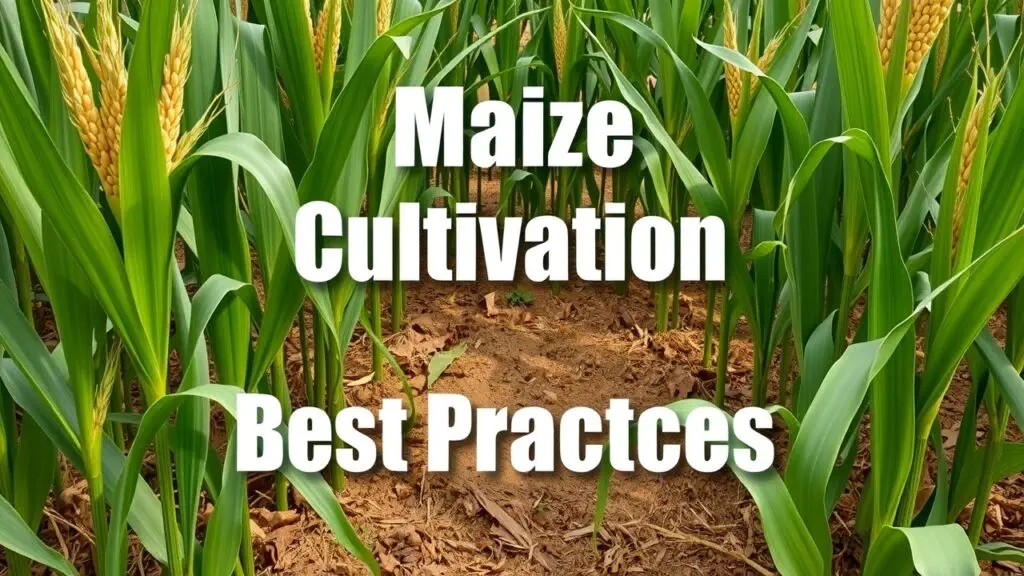Learn about the many types of maize, from dent corn to sweet corn and popcorn. This guide covers the main types of corn, providing a cheat sheet for identifying different varieties.
What is Maize?

Maize, known scientifically as Zea mays, is a key global staple crop. It is one of the main cereal grains that many people rely on for food. There are several different maize varieties, each with its own features that suit various uses.
Here are some common types of corn:
- Sweet corn: Eaten fresh or canned; it’s sweet and juicy.
- Field corn: Used mainly for animal feed and industrial products; it has more starch and less sweetness.
- Dent corn: Recognizable by the dent in its kernels; it’s often processed into food or feed.
- Flint corn: This type has hard kernels that can be ground into flour or used in traditional recipes.
- Popcorn: Has moisture in its kernels that makes them explode when heated.
Understanding these maize varieties is important for farmers. It helps them pick the best type to meet their needs and market demand.
Why Are There Different Types of Maize?
The variety in maize types comes from the genetic diversity within Zea mays. Corn genetics are vital because they determine how different strains adapt to various climates and soils. This diversity helps breeders create new hybrids. They aim to enhance yield, improve disease resistance, increase drought tolerance, and boost nutritional value.
Many factors influence the types of maize grown around the world. For example:
- Some regions prefer sweet varieties for local consumption.
- Other areas may grow field corns for livestock feed or industrial uses like making ethanol.
This range of options helps improve food security by providing choices tailored to local needs. It also supports sustainable farming practices. Farmers can adjust their crop choices based on changing climate conditions or market trends.
Classification and Overview of Maize Varieties
How Is Corn Classified?
Corn is classified based on the type of kernel it has. This classification helps determine how each type is used. Here are the main categories:
- Dent Corn: This corn has a dented top when mature. Farmers often use it for animal feed and in various industrial products because it is high in starch.
- Flint Corn: Flint corn has a hard outer shell. It is often found in traditional dishes and is also used as animal feed. Its smooth kernels help it resist spoilage.
- Sweet Corn: Sweet corn is known for its sugary taste. People usually eat it fresh or process it into canned or frozen goods.
- Flour Corn: This type of maize has a soft endosperm that grinds easily into flour. It’s popular for making tortillas and pupusas, which are tasty traditional foods.
- Popcorn: Popcorn can pop due to moisture inside its kernels when heated, making it a fun snack.
Knowing these classifications allows farmers to pick the right type of corn based on what they need.
Key Differences Between Each Variety
The differences among maize types can be seen in several ways:
- Kernel Structure:
- Dent corn has a soft starch core with a noticeable dent at the top.
- Flint corn features hard, smooth kernels that stand up well to storage.
- Composition & Nutritional Value:
- Dent corn has lots of starch but less protein compared to flint corn, which has more protein that benefits livestock health.
- Sweet corn shines with high sugar levels, making it great for eating straight off the cob instead of being processed or fed to animals.
This knowledge helps choose the best type based on specific farming needs or market demands while considering each variety’s nutritional benefits.
Detailed Guide to Major Types of Maize
Dent Corn Characteristics and Uses
Dent corn, or field corn, is one of the most common types of maize grown in the U.S. You can easily spot it by the dent on the top of its kernels as they dry out. This corn is packed with starch, which makes it useful for many things.
Key Characteristics:
- Kernel Type: Soft and starchy kernels with a noticeable dent.
- Growing Season: It takes a longer time to grow than other corns.
- Nutritional Content: Dent corn has lots of carbs and some fiber but isn’t sweet.
Primary Uses:
- Animal Feed: Much of this corn goes to feed livestock because it gives them plenty of energy.
- Ethanol Production: It’s a key ingredient for making biofuel through fermentation.
- Processed Foods: People use dent corn to make tortillas and cornmeal, which are common in many diets.
Flint Corn Features
Flint corn is unique because its kernels have a hard shell and come in bright colors like yellow, red, or blue. The moisture levels in flint corn are lower, making the kernels harder than those of dent corn.
Key Characteristics:
- Kernel Type: The hard kernels are tough and survive the harvest well.
- Protein Content: Flint corn usually has more protein than other types.
Culinary Uses:
Flint corn is popular in various traditional meals:
- Polenta: A thick dish made by cooking ground flint corn until it becomes firm.
- Hominy: Made by soaking dried flint kernels in an alkali solution; used in soups and stews.
Sweet Corn Traits
Sweet corn is different because it’s grown mainly for people to eat instead of livestock or industry.
Key Characteristics:
- High Sugar Content: Its sweetness comes from high sugar levels when harvested.
- Fresh Vegetable Status: Sweet varieties are picked while immature, so they taste fresh.
Harvesting Considerations:
Sweet corn comes in many types with different sweetness and shelf life:
- Some hybrids stay fresh longer after being picked, which helps buyers.
- Picking at just the right time is key; waiting too long turns sugar into starches and makes it tougher.
Understanding these main types of maize—dent, flint, and sweet—helps farmers and students alike figure out how to grow them based on what people need around the world.
Less Common Maize Types
Flour Corn Characteristics and Uses
Flour corn has a soft endosperm. This makes it great for grinding into fine flour. Many people use flour corn in Latin American dishes like tortillas and pupusas. It has a high carbohydrate content but is low in protein. Its importance varies from place to place. Learning about its uses can help us appreciate flour corn in different cuisines.
Popcorn Characteristics and Uses
Popcorn is special because of its unique kernel structure. When heated, the moisture inside each kernel turns into steam and makes the kernel pop! There are different types of popcorn. Butterfly popcorn has irregular shapes, while mushroom popcorn pops into round shapes. These differences matter for presentation and taste in dishes. Growing popcorn needs careful attention to soil and water conditions to get the best popping results.
Pod Corn Characteristics and Uses
Pod corn is different from other maize types because each kernel is inside its own husk or pod. Nowadays, it’s not grown much because it doesn’t produce as well as dent or sweet corn. However, pod corn is important historically for indigenous peoples who grew it. Knowing more about pod corn helps us understand ancient farming methods and efforts to protect maize diversity.
Additional Considerations on Lesser-Known Varieties
Besides the ones mentioned, there are other lesser-known types of maize worth discussing. Waxy corn has a special starch that’s high in amylopectin, making it useful for thickening foods. Ornamental corn is mainly grown for decoration rather than eating; it looks nice during harvest time or fall celebrations. High-oil corn has more oil, which makes it valuable for food production and biofuel use.
Each type of less common maize offers unique benefits, whether for people to eat or for industry use.
Nutritional Comparison of Maize Types
Importance of Nutritional Value
The nutritional value of different maize types is key for food security and sustainable agriculture around the world. Each type provides essential nutrients that support both human diets and livestock feed.
For example, sweet corn is packed with vitamins like A and folate, which are crucial for health; dent corn has higher carbohydrate levels, making it a great option for animal feed due to its energy boost.
Knowing these differences helps farmers select the right varieties based on their intended use—either for direct human consumption or as animal feed—supporting better agricultural practices.
Applications Based on Nutrition
Choosing specific maize varieties based on their nutritional benefits is vital for getting the best diets for livestock and people:
- Animal Feed: Dent corn is often chosen because it’s high in starch, giving animals the energy they need.
- Human Consumption: Sweet corn is more vitamin-rich while popcorn serves as a tasty low-calorie snack that’s higher in protein.
These choices highlight how different nutritional profiles affect farming decisions about which crops to grow.
Sources for Nutritional Data
Reliable sources like USDA data provide deep insights into the nutrition of various maize types along with respected research studies that detail these characteristics.
By looking at credible organizations such as the USDA or peer-reviewed agricultural journals, anyone can find thorough analyses that guide better choices about what to plant and how to use these crops nutritionally.
Understanding maize varieties not only helps farmers but also plays a big role in enhancing food security through well-informed agricultural practices focused on nutrient-rich crops.
Maize Cultivation: Best Practices

Planting Techniques
Maize cultivation starts with smart planting techniques to get the best growth and yield. Here are the main things to focus on:
- Seed Selection: Pick the right maize variety. Each type has traits that fit different climates and uses. For example, sweet corn is perfect for eating fresh, while dent corn is mainly for animal feed.
- Soil Preparation: Test your soil’s pH and nutrients before planting. This helps you know what to add, like organic or synthetic fertilizers, to create a good environment for your maize.
- Planting Density: The space between plants matters. If they are too close, they fight for sunlight, water, and nutrients. A good rule is to plant seeds 6-12 inches apart in rows that are 30-36 inches apart, but adjust based on the maize type.
Fertilization & Soil Management
Fertilization is key for meeting the nutrient needs of various maize types. Regular soil tests show what nutrients might be missing.
Farmers can use organic fertilizers like compost or manure or go for synthetic ones like nitrogen-rich fertilizers. Organic options help keep the soil healthy over time but may need more frequent applications than synthetic types.
Keep the pH levels right (about 6-7) to make nutrients available. This helps improve crop yields for different maize varieties.
Pest & Disease Management
Managing pests and diseases is vital for healthy crops. Common corn pests include aphids and rootworms. Diseases like gray leaf spot can hurt yields if not controlled quickly.
Integrated pest management (IPM) strategies mix biological control with chemical treatments when needed. Crop rotation also helps by breaking pest life cycles tied to certain crops.
Sustainable farming methods reduce harm to the environment while keeping productivity high through careful monitoring of both pests and crops.
Harvesting & Storage
Getting your harvest timing right boosts grain quality and quantity. The best time to harvest depends on moisture content; around 20% moisture usually gives better storage results without spoilage risks.
After harvesting, proper storage methods are key to keeping grain quality until it goes to market or processing places. Drying techniques differ among maize types but generally should bring moisture below 15%. Store in cool places out of sunlight to stop mold growth and insect problems.
Choosing the Right Maize for Your Needs
Factors to Consider
When picking the right type of maize, a few key factors matter. Thinking about these will help you choose the best variety for your farming goals and local conditions.
- Intended Use: Different types of maize have different uses. Sweet corn is mainly for people to eat, while field corn is often used for animal feed or making products. Knowing what you want to do with the maize will help narrow down your choices.
- Maize Varieties: There are many maize varieties, such as dent corn, flint corn, and popcorn. Each type has special traits that can affect how well it grows and how much you can harvest.
- Climate: The weather in your area plays a big role in growing maize. Some varieties do well in hot climates, while others prefer cooler temperatures.
- Soil Type: The quality of your soil is important for crop yields. Knowing if your soil is sandy, clayey, or loamy will help determine which type of maize will grow best in those conditions.
- Crop Yields: Looking at potential yields from different maize types can guide you in selecting a variety that matches your production goals.
By keeping these factors in mind—like intended use, available varieties, climate suitability, soil quality, and expected yields—you can make a smart choice about the right kind of maize for your needs.
Decision-Making Guide
To help further in selecting the right maize variety based on its classification and intended purpose:
- Start by figuring out what you want from the crop (for example, food items like sweeteners or animal feed).
- Use a decision tree method where each choice leads to different options based on previous answers regarding usage.
For instance:
- If you’re looking at sweeteners made from crops like high-fructose corn syrup versus animal feed made from field corn silage.
This structured approach helps farmers consider their options carefully based on their specific needs while ensuring they select a suitable type among various classifications available today.
In short, knowing both general categories (like sweet versus field) and individual traits (like kernel structure) gives growers essential information needed when choosing different types of maize suited to meet distinct agricultural goals effectively!
FAQs About Types of Maize
What is the difference between sweet corn and field corn?
Sweet corn has high sugar content and is consumed fresh. Field corn, or dent corn, is starchier and used mainly for animal feed and industrial products.
What are some lesser-known maize types?
Lesser-known types include blue corn, chuspillo, and waxy endosperm corn. These varieties offer unique flavors and nutritional profiles.
How does maize contribute to food security?
Maize varieties support food security by providing diverse options for consumption and livestock feed, adapting to different climates and soil conditions.
What is high-lysine corn?
High-lysine corn has increased lysine levels, improving its nutritional quality for both humans and livestock.
What are the uses of ornamental corn?
Ornamental corn is primarily grown for decoration. Its vibrant colors make it popular in fall displays and festive decorations.
Exploring Lesser-Known Maize Varieties
- Pod Corn: Each kernel grows inside a husk. This variety is rarely cultivated today but has historical significance.
- Chullpi Corn: Chullpi offers a unique flavor profile. It is often roasted or used in traditional dishes.
- Iochief Corn: This type thrives in cooler climates. Farmers favor it for its adaptability.
- Papoon Corn: Papoon has a distinct texture that makes it ideal for specialty foods.
- Golden Bantam Corn: This heirloom variety stands out for its sweetness. Many people use it for fresh eating.
- Pearl Popcorn: Pearl popcorn pops into a light snack. It has a tender texture that many enjoy.
- Corn Grits: Made from ground corn, grits serve as a hearty side dish or breakfast option.
- Hominy: Hominy is treated with an alkali solution, enhancing its flavor and digestibility.
- Masa Harina: Masa harina is flour made from treated maize. It’s essential for tortillas and tamales.
These varieties enrich the understanding of maize’s diversity in cultivation and culinary applications.
Related Topics
- types of corn
- types of popcorn
- types of corn kernels
- types of corn for animal feed
- types of corn flour
- types of corn for tortillas
- types of maize varieties for different climates
- types of maize based on kernel structure
- types of maize based on nutritional value
- types of fertilizers for maize
- types of pests affecting maize
- types of diseases affecting maize
- types of maize harvesting techniques
- types of maize storage methods
- types of heirloom corn
- types of corn seeds
- types of corn used for ethanol production
- types of cornmeal
- types of polenta
- types of hominy



Types of Maize: A Complete Guide to Corn Varieties